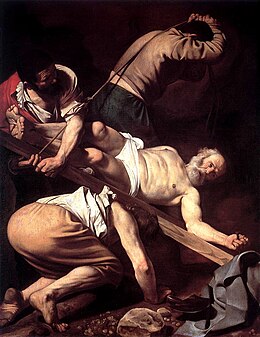การตรึงกางเขน

การตรึงกางเขน (อังกฤษ: crucifixion) เป็นวิธีการประหารชีวิตซึ่งผู้ถูกสั่งให้ประหารจะถูกผูกหรือตอกตะปูบนไม้กางเขนและปล่อยทิ้งไว้ให้ตาย วิธีการประหารชีวิตแบบนี้เป็นวิธีที่ใช้ในสมัยจักรวรรดิโรมันและในประเทศเพื่อนบ้านในบริเวณเมดิเตอร์เรเนียน และวิธีที่คล้ายคลึงกันในจักรวรรดิเปอร์เชีย[1] การประหารชีวิตโดยการตรึงกางเขนโดยจักรวรรดิโรมันมาจนถึงปี ค.ศ. 337[2] หลังจากที่คริสต์ศาสนาเป็นศาสนาที่ถูกต้องตามกฎหมายของจักรวรรดิโรมันเมื่อปี 313 โดยจักรพรรดิคอนสแตนตินที่ 1 แต่การใช้วิธีตรึงกางเขนก็ยังใช้กันอยู่บ้างในหลายที่ในสมัยใหม่
“กางเขน” (Crucifix) ที่เป็นรูปสัญลักษณ์ของพระเยซูถูกตรึงบนกางเขนเป็นสัญลักษณ์ที่สำคัญของผู้นับถือศาสนาคริสต์ แต่ในนิกายโปรเตสแตนต์บางครั้งจะนิยมใช้กางเขนที่ไม่มีพระเยซูมากกว่า
การตรึงกางเขน
การตรึงกางเขนจะไม่ใช้ในการทำพิธีกรรมที่เป็นสัญลักษณ์ แต่จะใช้ในการที่ทำให้ผู้ตาย ตายอย่างทรมาน (ทำให้เกิดคำว่า “excruciating” หมายความว่า “out of crucifying” ซึ่งหมายถึงความเจ็บปวดที่ทารุณ), สยดสยอง (เพื่อทำให้คนขยาดจากการทำในสิ่งไม่ดี), และทำในที่สาธารณะ การตรึงกางเขนก็ต่างกันไปตามแต่ละสถานที่และยุคสมัย
ภาษากรีกและละตินที่เกี่ยวกับการตรึงกางเขนก็มีหลายลักษณะตั้งแต่ ตรึงกับเสา, ตรึงกับต้นไม้, ตรึงกับไม้รูปต่าง ๆ[3] ถ้าใช้ไม้ไขว้ผู้ที่ถูกตรึงก็จะถูกบังคับให้แบกไม้บนบ่า เดินไปยังสุถานที่ที่จะถูกตรึง ซึ่งอาจจะทำให้เนื้อบนไหล่ฉีก น้ำหนักของกางเขนก็จะหนักประมาณ 135 กิโลกรัม[4] แทซิทัส (Tacitus) นักประวัติศาสตร์โรมันบันทึกไว้ว่า ที่โรมมีสถานที่สำหรับการตรึงกางเขนเป็นการเฉพาะ อยู่ที่นอกประตูเอสควิลิเน่ (Esquiline Gate)[5] และมีบริเวณเฉพาะสำหรับการประหารชีวิตทาสโดยการตรึงกางเขน[6] สันนิษฐานกันว่า ตรงที่ตรึงกางเขนจะมีเสาตรงปักไว้แล้วเป็นการถาวร และเมื่อมีผู้แบกไม้มา (หรืออาจจะตรึงแขนไว้กับไม้แล้วก็ได้) ก็ยกทั้งคนและไม้ขึ้นไปประกอบกับเสาตรงที่ปักถาวร
บางครั้งผู้ที่ถูกประหารชีวิตก็อาจจะถูกผูกกับไม้ด้วยเชือกหลังจากที่ถูกตรึง ตามที่บันทึกโดยนักประวัติศาสตร์โจซีฟัส (Josephus) ซึ่งกล่าวถึงสมัยที่กรุงเยรูซาเลมถูกล้อมเมื่อ ค.ศ. 70 ถึงการตรึงกางเขนผู้ที่ถูกจับด้วยวิธีต่าง ๆ ของทหารโรมัน[7]และใน จอห์น 20:25
วัตถุที่ใช้ในการตรึงกางเขนเช่น ตะปู เป็นสิ่งที่แสวงหากัน เพราะถือเป็นเครื่องรางช่วยป้องกันภัย[8]
อ้างอิง
- ↑ "The first recorded instances of crucifixion are found in Persia, where it was believed that since the earth was sacred, the burial of the body of a notorious criminal would desecrate the ground. The birds above and the dogs below would dispose of the remains."
Smith, Damian Barry, The Trauma of the Cross: How the Followers of Jesus Came to Understand the Crucifixion, p. 14. Paulist Press: Mahwah, New Jersey, 1999. - ↑ "Crucifixion". คลังข้อมูลเก่าเก็บจากแหล่งเดิมเมื่อ 2008-04-01. สืบค้นเมื่อ 2008-02-29.
- ↑ Seneca the Younger wrote: "I see crosses there, not just of one kind but made in many different ways: some have their victims with head down to the ground; some impale their private parts; others stretch out their arms on the gibbet" (Dialogue "To Marcia on Consolation", 6.20.3).
- ↑ "Crucifixion in the Ancient World". คลังข้อมูลเก่าเก็บจากแหล่งเดิมเมื่อ 2008-05-28. สืบค้นเมื่อ 2008-02-29.
- ↑ Annales 2:32.2
- ↑ Annales 15:60.1
- ↑ Jewish War V.II
- ↑ Mishna, Shabbath 6.10, quoted in Crucifixion in Antiquity
Text is available under the CC BY-SA 4.0 license; additional terms may apply.
Images, videos and audio are available under their respective licenses.
